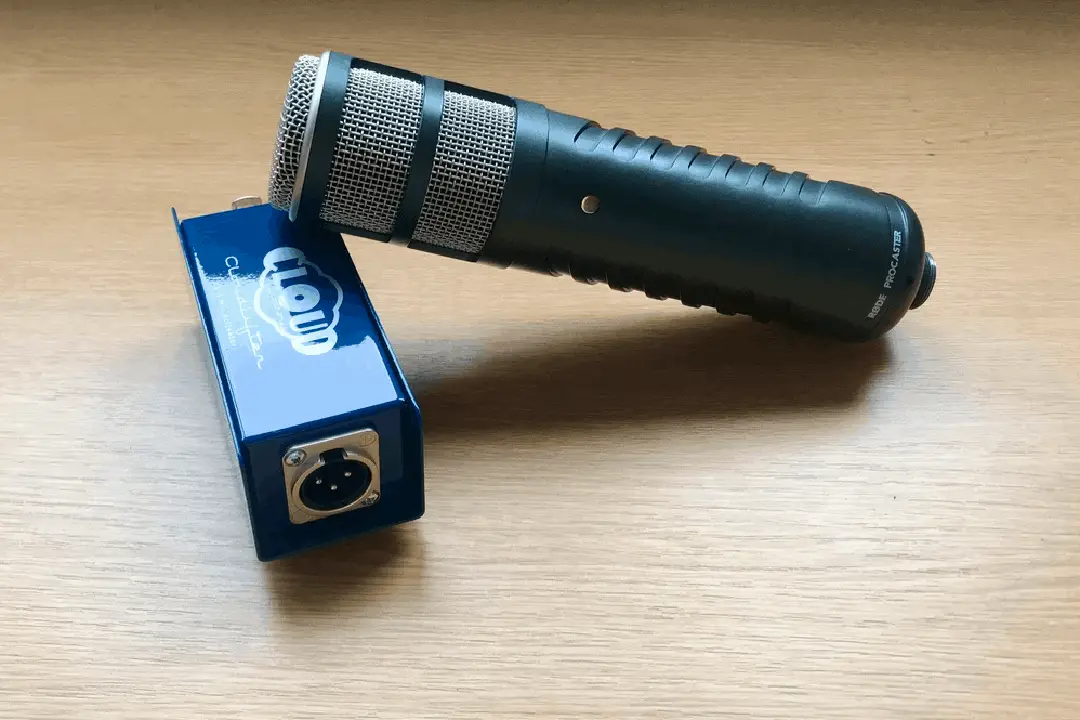The Rode Procaster is a trailblazer in the dynamic podcasting microphone market. Thanks to the passive nature of the microphone, it is a robust piece of kit that can easily endure a life on the road. It’s low sensitivity also means it is guaranteed to provide crisp high-quality audio, even in noisy environments.
This low sensitivity is a double-edged sword though, as this means that the microphone is incredibly gain hungry. Due to it being passive, the microphone contains no internal amplification system like a condenser microphone, and so getting a decent signal level is quite the battle.
Does the Rode Procaster need a Cloudlifter? Absolutely. This microphone will benefit from every boost you can give it, and products such as the Cloudlifter CL-1 are tailor-made to provide low output microphones such as this a much-needed gain boost.
By giving the Procaster a 25dB boost before the signal hits the desk, you are lessening the amount of gain your preamps will have to provide. This is a great idea if you are using a budget interface as entry-level preamps are prone to dragging up the noise floor and coloring the signal when used in excess. Adding a Cloudlifter will give you the gain you need and save you time EQing any damage done.
But don’t just take our word for it. Keep reading to see our very own Procaster tests both with and without the inclusion of a Cloudlifter to see just how much of a difference mic activation makes on this microphone.
Table of Contents
A bit about the Rode Procaster
The Rode Procaster is a broadcasting microphone purpose-built for use with vocals. This is evident with the built-in pop filter and internal shock mounting, reducing vocal plosives and mechanical transmission in the low end, ensuring your vocals are as clean and quiet as possible. Special care has been taken by Rode to configure the Procaster’s frequency response to guarantee a near broadcast quality tone right out of the box.
In terms of build quality, the Procaster is built like a tank. The device weighs in at a hefty 745g with an all-metal casing, so you can bet this microphone feels like it is built to last.
The first dynamic microphone produced by Rode was the M1, a competitor to the industry standard that is the SM58. The next in line is the award-winning Podcaster. This was Rode’s first venture into USB connecting microphones, and this high output dynamic microphone is an exceptional product. The Procaster, being an evolution of the Podcaster, only improves on what were already incredible specs.
| Frequency Response Range: | 20 Hz to 20 kHz |
| Sensitivity: | -57.0dB re 1 Volt/Pascal (1.60mV @ 94 dB SPL) +/- 2 dB @ 1kHz |
| Polar Pattern: | Cardioid |
| Output Impedance: | 320Ω |
| Connectivity: | XLR |
| Weight: | 937g |
What is a Cloudlifter and what does it do?
So why have we picked the Cloudlifter as our gear of choice when it comes to mic activation? Let’s breakdown why the CL-1 is one of the best low-noise gain boosters money can buy.
The Cloudlifter mic activator is an inline signal booster that you simply attach in between your microphone and mixer, and once provided with phantom power will amplify your signal with clean and transparent gain.
This is an incredible asset to your setup when using a dynamic microphone such as the Rode Procaster, as the low mic sensitivity leads to low output, which means without mic activation hardware you will have to crank up your preamps to get a decent signal. But if you can get the right signal with preamps then why is the Cloudlifter necessary? Well, the trouble with preamps is that the higher they are pushed, the more noise and color they add to the signal.
A Cloudlifter helps boost the signal before preamps can touch it meaning that when the signal reaches your mixer, there is less boost required, and therefore less noise and coloration.
Test results without a Cloudlifter
Now you understand why it is a Cloudlifter is necessary with a microphone such as this, let us take a closer look at just exactly how much of a difference a Cloudlifter makes.
As you can see in the image below, we have recorded some room tone with the Procaster running straight into a Focusrite Scarlett 2i2. The gain is at half capacity in this graph, and even with a small boost, we needed to add 50dB of gain in postproduction to graph this chart. This is an absolutely minuscule amount of signal, even when recording room tone, and when recording vocal takes this will become an immediate issue.

You may wonder why it is we are recording room tone for this test, and there is a good reason. Room tone allows us to understand the noise floor of the microphone (how much background noise it picks up) and to make this test as realistic as possible, it has been conducted in a relatively untreated room. From this test, you can see the pull of the Procaster, as the background noise level is little to none.
Test results with a Cloudlifter
Looking at the graph below, it’s clear to see how much better the signal level is looking with the addition of the Cloudlifter. The bottom end caps at -18 dB which when you consider that this test was conducted with as little input in the mic as possible, is a very good sign. For the sake of fairness, a 50dB boost has been added in post-production, however, it should be clear to see that the addition of a Cloudlifter really pushes this low output microphone signal up into usable territory.

Not only is this signal more than adequate for vocal recording, without much additional gain from preamps, but the noise floor is still incredibly low. This graph is proof if proof was needed of how clean the gain boost is. As you can see, the noise floor has moved up around 22dB with the rest of the signal. If this were a cheap preamp, you would reasonably expect that the noise floor would receive much more of a boost in relation to the overall signal increase.
This test proves why the CL-1 is the go-to product for mic activators, its high and clean signal boost can save even the lowest output dynamic microphones on the market.

In conclusion
From reading our thoughts and tests with the Rode Procaster, you should able to see for yourself the benefits of the addition of a Cloudlifter when recording. While some microphones have an incredibly low output and, in most cases, require some form of mic activation in order to get the most out of them, there are some exceptions in which preamp gain may be all you need. If you want to learn more about when it is you should use a mic activator, then we suggest our article Is a Cloudlifter Necessary?
Let’s say you are sold on the benefits of a mic activator in your podcasting setup, great, but what mic activation alternatives are out there? Check out our Cloudlifter Alternatives article to learn more. If you want to see how the Cloudlifter chalks up to another titan in the mic activation scene, then our FetHead vs Cloudlifter comparison is worth a read.

